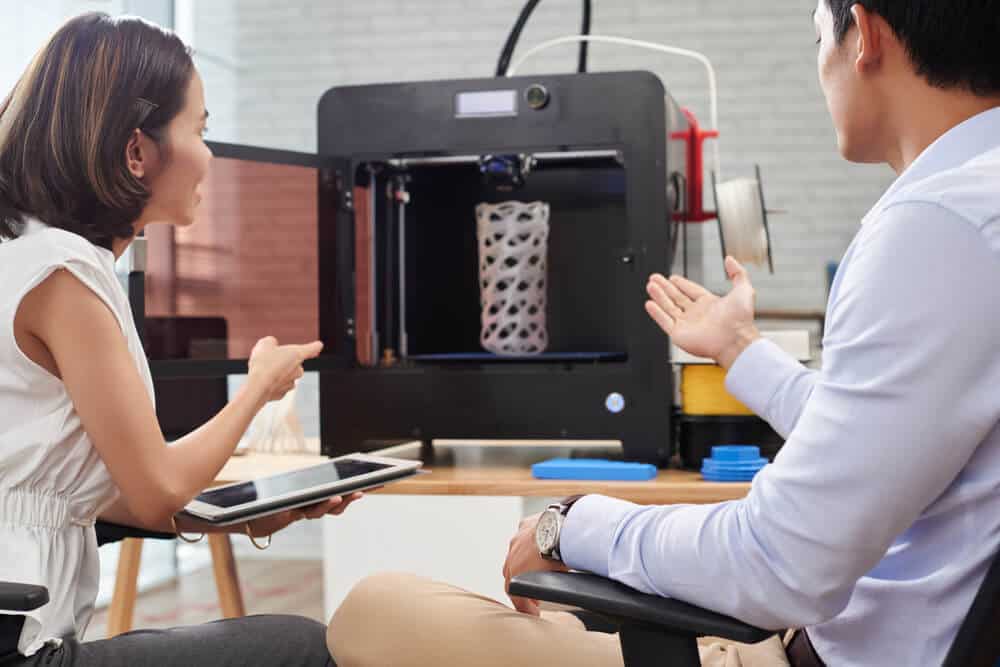Are you looking for the best 3D printer Australia has to offer? In the last few years, many brands have launched 3D printing models varying in price from a few hundred dollars up to $50k+.
Today we'll show you some of the most affordable residential and commercial 3D printers that are highly rated online, work with affordable materials and are easy to fix should issues arise.
The team at Best Five, have spent the last few weeks playing around with 3D printers, so that we can bring this awesome guide to you, and help you make a good buying decision.
You definitely don't need the most expensive 3d printer, but if you want to print your own products at home, most of these units will offer that functionality.
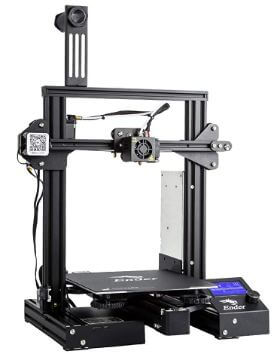
1. Comgrow Creality Ender 3 Pro 3D Printer
The Comgrow Creality Ender 3 Pro comes with lifelong technical assistance and a 24-hour customer service hotline to resolve any mechanical mishaps or inquiries.
This is an ideal beginner product for those new to 3D printing and is especially great for forming mechanically engineered structures using Fused Deposition Modeling (FDM). Furthermore, this is machine is catered towards kids and students interested in STEM subjects.
The magnetic bed is designed to prevent heat damage and make taking away printed products a hassle-free chore. It only takes a maximum of 5 minutes to heat up the hot bed to 110℃. Power is provided through a UL Certified power pack, preventing overheating.
This 3D printing device also has a feature which automatically resumes printing if a power cut occurs, preventing unfinished models. In order to provide a sturdy structure, this printer has been engineered with a 40*40 y-axis layout. An LCD screen provides a panel to print objects.
The printing volume is 220 x 220 x 250mm and with a speed of 200mm/s, this device is compatible with Cura, Repetier-Host or Simplify3D.
A MK-10 Extruder has also been fitted to minimize extrusions from occurring. A V-slot with POM wheel is also equipped to create seamless and quiet mechanics.
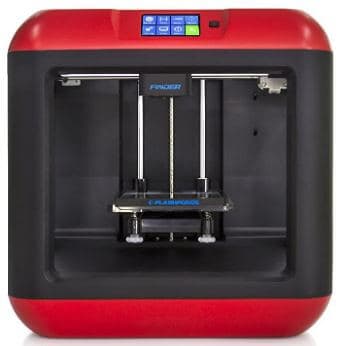
2. Flashforge Finder Plus 3D Printer
The Flashforge Finder Plus is a 3D printer catered towards use by young children to create small and simple structures using fused filament fabrication (FFF). A print volume of 140 x 140 x 140mm can be expected with a speed of 30-150mm/s.
It is made out of a plastic alloy material, providing a study structure. The maximum temperature of the extruder is at 240℃. The build plate can be detached from the main body of this machine which makes it easy to take out printed models without the risk of burns.
The exclusion of a heated platform makes it kid-friendly as well and further prevents heat damage. This printer is almost silent, with a noise level reaching a maximum of 50dB.
There are a variety of ways to connect to this machine including through a simple USB stick or Wi-Fi connection for wireless control. To control what gets printed, there is a small touchscreen display. A notable feature is a separate filament box that keeps messes to a minimum.
A variety of filaments are compatible with this 3D printer such as wood, PLA and TPU 95 Software that functions well with this device include Flashprint.
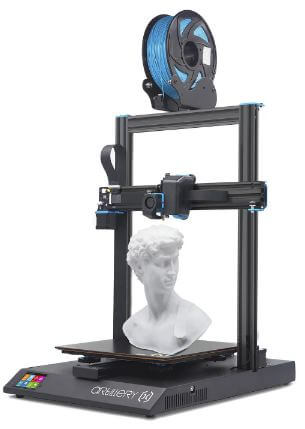
3. Artillery® Sidewinder X1 3D Printer
The Artillery® Sidewinder X1 is the 4th and latest version from the Artillery X1 line with Fused Filament Fabrication (FFF) technology. With a print volume of 300 x 300 x 400mm, this is a machine ideal for printing out larger structures.
There is a printing speed of up to 150mm/s which is faster than average. The construction involves an aluminum chassis to provide both stability and durability. The build plate can reach a temperature of 80℃ in under 120 seconds.
The maximum temperature that can be reached is 240℃. Connection can be enabled through a memory card or a USB stick. To decide what models to print, there is a touchscreen colour display with a user-friendly interface.
This machine is equipped with a stepper driver that has low-noise characteristics, producing sounds less than 60dB. There is also a special feature that allows printing to continue as left off, if an unexpected power outrage occurs.
A purchase of this product is inclusive of customer service support. This 3D printer comes out of the box 95% pre-assembled, saving time. Filaments that work with this device include HIPS, PLA, wood, PVA, ABS and others. The slicing software, Cura can be used with this product.
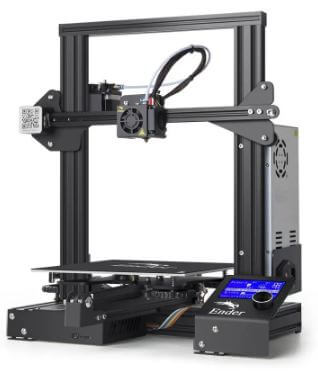
4. Creality 3D® Ender-3 3D Printer
The Creality 3D® Ender-3 I3 is a smaller and more compact machine, designed for novice printers with the integration of Fused Depositing Modeling (FDM). There are quick-printing enablers such as the hotbed which can go up to 100℃ in under 5 minutes.
Smaller models can be printed with a printing volume of 220 x 220 x 250mm and the printing speed is listed at 30-60mm/s. In order to initiate the printing process, connection must be enabled either through an SD card or USB flash drive.
Only low-level noises are produced through the patented V-slot with POM wheel. An addition of the patented MK-8 Extruder prevents plugging accidents. Control is enabled through an LCD screen with one knob that can be turned to select different settings.
To removed printed structures, this device utilizes a magnetic platform sticker instead of masking tape. Printing that has not finished due to a small power outrage can continue after power has come back on.
There are a wide range of 1.75mm filament types that can be used in conjunction with this machine such as PLA, wood, copper, ABS, TPU and gradient. This 3D printer runs with either Cura, Reptier-Host or Simplify3D slicing software. This product requires assembling before use.
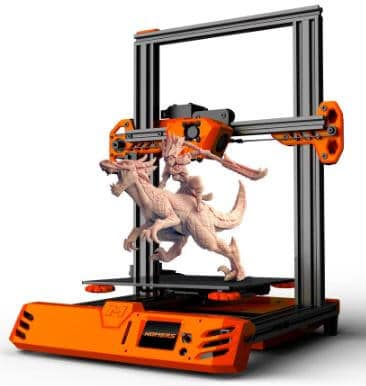
5. HOMERS/TEVO® Tarantula Pro
The HOMERS/ TEVO® Tarantula Pro is a 3D printer with a print size of 235 x 235 x 250mm that is best utilized for creating furniture and movie props with intricate details using Fused Filament Fabrication (FFF).
This printer can also be used to generate complex architectural buildings and is suitable for those who want to level up from beginner products. This device can also print at a speed of 60-150mm/s. It takes less than 1 minute for the build plate to reach 70℃.
The maximum temperature reached is at 240℃. Noise levels are low with this product, with an advertised maximum level of 60dB due to the stepper drivers. The risk of overheating is regulated by the cooling fan.
Heat protection is also given through the safety power supply. To control what gets printed, there is a touchscreen panel. Connection can be made through a regular USB flash drive or an SD card.
This product is compatible with various slicing software such as Cura, Simplify3D, Sli3r, EasyPrint 3D and much more. Filaments that work well include HIPS, wood, PVA, flexible PLA and regular PLA. This 3D printer requires assembling before operating.
Where to buy the best 3D printers?
You'd think for a product such as a 3D printer you'd be able to buy them in pretty much any electronics store such as Bing Lee, Harvey Norman and JB HiFi.
Well you'd be wrong! Still in it's infancy, 3d printing isn't something we all need..yet anyway, so these retailers haven't invested in large quantities of 3d printers.
You will need to use specialist printing retailers, or marketplaces such as Amazon.com.au and Banggood.com, which connect smaller retailers with a large client base.
Most of the models mentioned above, can be found on Amazon which offers fast shipping and a reliable warranty process.
But once you've bought your printer, you need to buy material to actually print. Choosing a 3d printer that offers universal plastic spools is definitely recommended.
What materials can a 3D printer use?
You'll be pleased to know that 3D printers can make use of various types of filament for fused deposition modelling printers.
These include, ABS, PLZ, PVA, Nylon, HDPE, T-Glase/PETT, Wood Filament, Metal Filament, Carbon Fibre mix, Flexible Filament and Conductive Filament.
You can learn more about these materials using this guide on Toms Guide.
What's the cheapest 3D printer in Australia?
After much deliberation, researching and price comparison, we believe that the cheapest model is the TEVO Tarantula Pro from Banggood. This is from their Australian stock, so isn't a Chinese import as they do have a warehouse over there too.
However for the extra $100 you could consider buying an Australian model, that comes with a customer support team in Australia and is much easier to source parts and lodge warranty claims should the need arise.
After checking out the best 3D printers to buy online in Australia, be sure to checkout our other guides, on similar topics:
- 5+ Best Home Mesh WiFi Systems For Better Wireless - May 21, 2022
- 6+ Best Heat Resistant Gloves For The Ultimate Grill - May 21, 2022
- 5+ Best Power Towers For The Ultimate Workout - November 30, 2021
Last Updated: December 13, 2020 by Rhys
